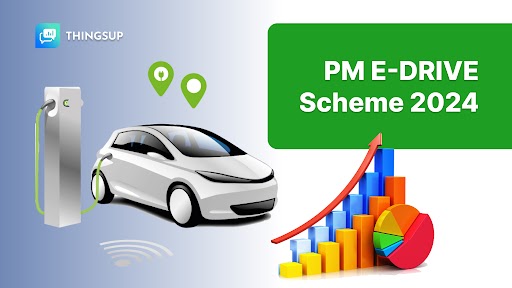This PM e-drive Scheme aims to improve the energy efficiency of private and public transportation. This Scheme has replaced the old FAME (Faster Adoption and Manufacturing of Hybrid and Electric Vehicles) program. After analyzing the slower pace of electric vehicle adoption, this initiative was taken. It aims to fix those issues by providing subsidies, financial incentives, and infrastructure development.
Key Goals of the PM e-drive Scheme:
- To grow the number of people buying electric vehicles across all market segments.
- Increase the electrification of public transportation.
- Establish reliable electric vehicle charging stations.
- Support the production of electric vehicle parts in the local areas.
- Promote new electric vehicle safety measures.
How is the PM e-drive Scheme Different from the FAME 2 Scheme?
It is an updated version of the FAME II plan, with important improvements that enhance its scope and concentrate on India’s electric vehicle (EV) ecosystem. Here are the complete details as per the research reports.
Aspect | FAME II Plan | PM E-Drive Scheme |
Budgetary Allocation | INR 10,000 crore (approximately) | INR 10,900 crore |
Target Segments | Focused on two-wheelers (E2Ws), three-wheelers (E3Ws), and public buses | Expands to include electric trucks, ambulances, and more charging stations |
Subsidy Distribution | Focused on E2Ws with more extensive subsidies | Reduced E2W subsidies (INR 3,679 crore) and expanded to E3Ws and trucks |
Commercial EVs | Included commercial electric cars | Removed commercial electric car subsidies |
Electric Trucks | Not covered | Introduces subsidies for electric trucks (INR 500 crore) |
E-Ambulances | Not covered | Allocates INR 500 crore for electric ambulances |
Charging Infrastructure | Focused on select areas | Expands with INR 2,000 crore to support 72,300 fast chargers nationwide |
Subsidy Mechanism | More flexible, leading to misappropriation | Aadhaar-based e-voucher system for greater transparency |
The PM e-Drive Scheme expands the initiative’s scope to include electric vehicles, ambulances, and stronger charging infrastructure. At the same time, the FAME II scheme was heavily focused on public transportation and two- and three-wheelers. Besides, the implementation of a subsidy scheme that is based on Aadhaar ensures transparency and reduces the possibility of inappropriate usage of subsidies.
Who is Eligible for the PM E-Drive Scheme?
The Prime Minister’s E-Drive Scheme is aimed at a wide range of industries and individuals interested in electric vehicles. A breakdown of those who are eligible is as follows:
Individual Buyers: Individuals interested in purchasing electric two-wheelers (E2Ws) and three-wheelers (E3Ws) meet the requirements to receive subsidies under the PM e-drive scheme. The government ensures that subsidies are distributed through e-vouchers based on Aadhaar. This ensures that individual purchasers can use these financial benefits without issues.
Commercial Transport Providers: The initiative aids commercial sectors by including electric buses, trucks, and ambulances. Businesses engaged in freight and logistics can also take advantage of subsidies for electric trucks. Besides, the hospitals that provide emergency services can seek support for electric ambulances.
State Transport Undertakings (STUs): Public transport agencies operated by the state are also among the major beneficiaries. The government has allocated a large portion of the budget for agencies to purchase electric buses, marking a move towards decreasing urban pollution while improving the sustainability of public transportation.
OEMs (Original Equipment Manufacturers): Electric vehicle manufacturers who meet the safety and performance standards set by the scheme can participate. They need to ensure that buyers are Aadhaar-authenticated and use the e-voucher system for subsidy claims.
How Will the PM E-Drive Scheme Funds Be Distributed?
The INR 10,900 crore that has been allotted for the Prime Minister E-Drive Scheme will be strategically divided across a number of industries and projects in order to ensure maximum effect.
Sector | Allocated Funds (INR Crore) | Purpose |
Electric Two- & Three-Wheelers | 3,679 | Subsidies for electric two- and three-wheelers, with reduced focus on E2Ws. |
Electric Trucks | 500 | New inclusion, providing subsidies for electric trucks. |
Electric Ambulances | 500 | Deployment of electric ambulances for emergency services. |
Public Electric Buses | 4,391 | Procurement of 14,028 electric buses for public transport. |
Charging Infrastructure | 2,000 | Installation of 72,300 fast chargers across urban centers and highways. |
Total | 10,900 | Comprehensive coverage of EV infrastructure and transport segments. |
What is the Impact of the PM e-drive Scheme on EV Adoption in India?
The PM e-drive Scheme is expected to strongly impact electric vehicle adoption in India. The initiative will encourage the expansion of electric vehicles in the following ways:
Factor | Impact on EV Adoption |
Cost Reduction | Financial incentives like subsidies lower the cost of EVs and make them more affordable for the average consumer. |
Infrastructure Development | The expansion of fast-charging stations reduces range anxiety and encourages more people to switch to EVs. |
Public Transport Electrification | Electrifying public buses will reduce carbon emissions and create a sustainable public transport network. |
Support for Commercial EVs | Promoting electric trucks and ambulances will encourage businesses and public services to adopt EVs. |
The government estimates that deploying 14,028 electric buses and 2.479 million electric two-wheelers will greatly reduce the country’s carbon footprint. This will also strengthen the electric vehicle industry.
Conclusion
The PM e-drive Scheme is an initiative that addresses the financial, infrastructural, and technological challenges associated with EV adoption in India. The Scheme will play a bigger role in transforming India’s transportation sector by offering subsidies, expanding the charging infrastructure, and promoting the electrification of public and commercial transport.
As the electric vehicle revolution continues to expand, Thingsup offers assistance with electric vehicle monitoring solutions. These solutions include real-time data analytics, diagnostics, and performance insights that guarantee optimal vehicle management for fleet operators as well as individuals.
FAQ's
The PM E-Drive Scheme is an initiative by the Indian government to promote the adoption of electric vehicles across various sectors. Notably, it replaces the FAME scheme and furthermore provides subsidies, infrastructure support, and incentives for EV purchases. In addition, this initiative aims to create a more sustainable transportation system, ensuring that EV adoption grows rapidly.
The PM E-Drive Scheme strategically provides subsidies to make EVs more affordable for everyone. Moreover, it expands public transport electrification, while also supporting the deployment of electric trucks and ambulances. Additionally, it builds a fast-charging infrastructure to address range anxiety, ensuring that EV users have reliable access to charging stations.
The Scheme aims to support the purchase of 2.479 million electric two-wheelers, 316,000 electric three-wheelers, and 14,028 electric buses.
Thingsup provides advanced electric vehicle monitoring solutions that help businesses and individuals track vehicle performance, enhance fleet management, and improve battery diagnostics.






